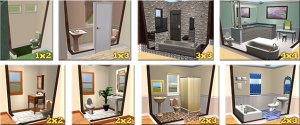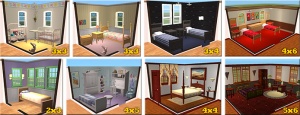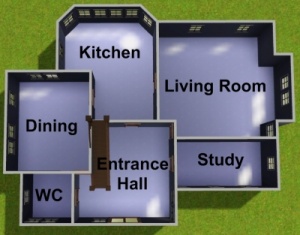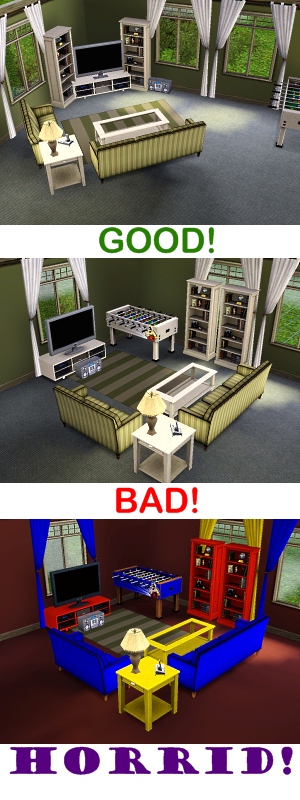Tutorials:Building Great Realistic Houses - From the Ground Up/Interior
| Building Great Realistic Houses - From the Ground Up: Main Page | Introduction and general info on getting started with your house. |
|---|---|
| Exterior | Building the shell of your house, roofs, windows, and landscaping. |
| Interior | Room sizing and layout, decorating, furnishing, and all the fun details. |
Contents |
Interiors
Once you have the basic shell of your exterior done, you'll need to find some way to split up the cavernous interior space you've created, and furnish and decorate it. Even if you're no architect or professional interior decorator, you can still make nice homes that look realistic and attractive, using these tips.
Room Sizes
This is one of the first stumbling blocks beginning builders run across. Without any concept of sim-scale, most people build massive rooms that are way out of proportion with reality. While there are plenty of gigantic mansions out there in the real world, doing these well in-game is not a beginner project.
Look at the room you're sitting in, and try to figure out how many sim-tiles the room would be. A tile roughly equates to 3 feet or 1 meter. Desks are about 2 tiles wide and 1 tile deep - single beds 3 tiles long, 1 tile wide, and double beds the same length and 2 tiles wide. How big is your room in proportion? And unless you've just moved in, it's probably not full of empty spaces with nothing there - maybe one or two "tiles" of empty space, but not tons.
Sim rooms should be about the same - plan the room size around the amount of stuff you're going to put in. You don't have to fill up every tile, but there shouldn't be room to go roller skating in the middle of the living room.
With the ability to measure out a real room in sim tiles it easier to understand the scale. Below are suggested ranges for room sizes in most "normal family homes." These are not hard rules, but guidelines. It is completely possible to make houses that do not follow any of these sizes at all, but its good to get the basics down first before attempting the mansions or the minilots. These guidelines are meant as a general overall size estimate - you don't necessarily want to build little boxes in these exact sizes.
Bathrooms
A half bath (toilet and sink) can be as small as 1x3 with the door in the center. You could remove the sink and just have a toilet and have one as small as 1x2! However, really tiny rooms can have traffic issues if you've got multiple sims in the home, so don't go too small.A nice sized half bath is 2x2. Put the toilet on one wall the sink on the other and a plant or table in the dead space. It's functional but still reasonably scaled.
Full baths (with a tub or shower) can be as small as 2x3. These are especially nice as the upstairs main bath (the one that connects to the hallway or kids rooms). 3x3 also still works especially if you wish to include both a shower and a tub. 3x3 is a nice sized master bath, and you can go as large as 4x4 without it looking too out of place.
If you wish to make it more of a master "spa and retreat" and include a hot tub you will obviously need more space. "His and hers" counters and sinks take up more space. Making rooms bigger is perfectly fine as long as it has a purpose. If you make the room too large and don’t fill it or break it up into little areas with decorative fences, half walls, or stages, it feels too large and empty. And of course, a larger bathroom with these additional features is really only appropriate in a larger, more complex, and more expensive house.
Bedrooms
Bedrooms can range between being a tiny 2x3 (not really big enough, not advised) to much larger master suites. Second bedrooms, kids' bedrooms, etc., should be at least 3x3, though 4x4 is more comfortable and a good size for most normal homes. 3x3 is good for a nursery but not usually roomy enough for kids and teens.For a master bedroom, 4x4 is the smallest possible size, with just enough space for a double bed in the middle of the room. 5x6 is nicer, with room for a dresser or a sitting area. Generally, you shouldn't go any larger than 6x6 unless it has a specific purpose such as an attached reading nook or sewing area.
Kitchens
Kitchens sizing usually depends mainly on the number of counters you want to use.
Look at your own kitchen and see how many "tiles" it would be. How many counter spots do you have? If you want to build a larger kitchen and you don't live in a big house, find pics online - unless it's an actual large restaurant kitchen, it's not going to have more than 10 counter spots.
At a minimum, you need one to prep food on and one to put a sink into, but usually there is more counter space than that. 4 counter spaces tends to make a nice but small kitchen, not including any island counters with barstools. Of course, don't overdo the number of island counters too - it can look awkward if you have too many. Having between 2 and 4 is just the right number. Any more than four tends to make the area look too long and at that point it would be more efficient to just have a table. Even four is pushing it though in a small kitchen, so take a good hard look at it if you have that many to make sure your kitchen can support it.
Most normal kitchens are either a square or a rectangular in shape, depending on the space you have given it in the house. Anywhere between 3x4 and 5x6 for the overall room size is perfectly decent and plenty of space. You can go a bit bigger if you have an adjoining dining room.
Dining Rooms
At a minimum, a dining room with a 1 tile table and four chairs needs to be 3x3. 5x5 is a little easier for sims to move around but still allows you to center the table, and put a plant in the corner. For a longer table, make sure you have no more than a few tiles around it unless you have a sideboard or other decorative feature to place in the room. Think about how many sims are realistically going to be eating at the table at once - unless the house is built for 8 sims, you probably only need a 1x2 table and a max of 6 chairs.
For smaller houses, you may not need a completely separate dining room - it can be attached to the kitchen and/or living room as a separate area, but still should be a fairly small area.
Living Room
Living room sizes can vary wildly, but generally, 3x3 will get you a little TV den. 4x4 is a bit more comfortable, with room to include a bookcase. 5x5 will give you a tv area and maybe a separate reading area or a chess table. A little larger and you have room for a pool table, piano or separate conversation seating area. 6x6 is probably the biggest you'd want to go for most homes. Remember, you don't want a bunch of empty space - if you find you have a lot of empty tiles you don't know what to do with it, shrink the space or divide it into areas or another room entirely.
Room Placement, Traffic Patterns, and Hallways
You not only want rooms that are the right size, but in an appropriate place in your home, for both realism and function.Rooms should be in proportion with one another - the bathroom shouldn't be bigger than your kitchen, or as large as your bedrooms. Bedrooms, living room, and den can be large-ish rooms, while the kitchen and dining room should be medium-sized, and bathrooms the smallest.
Think about the way sims are going to move inside your home. If it helps, plot their day from waking up, having a shower, having breakfast, going to work, coming home, socializing, entertaining themselves, and heading back to bed. Imagine the paths they'll have to take to get to where they're going. Are you forcing your sims on convoluted routes that don't make sense? Are doors, arches, and hallways placed in the best spots for traffic control? Sims are stupid and tend to get into traffic jams, so offer them alternate routes, and don't have them spend half their lives hiking from one room to another.
One good way of making sure sims can access everything easily is to build a main room or hallway that has easy access to every room on that level - a room or hall that can be primarily used for traffic rather than having its own function. If you look at the image on the right, you'll see the hall lets you access the washroom (WC), dining room, kitchen, lounge, and study.
While very old historical homes (medieval and the like) may not have hallways, for most sim homes you still need to think about traffic patterns, and create "semi hallways" - that is, areas inside rooms that are mostly furniture free and a straight shot from one door or arch to another, functioning as a hallway inside a particular room. This will allow your sims to get around without a stomping complaining fit.
And of course, rooms with similar functions should be placed near each other. The dining room and kitchen should be nearby one another. A living room usually has the kitchen and study nearby.
Avoid placing rooms that can only be accessed by going outside and then back in again - this sort of design is rare in real homes, and especially in TS2 with Seasons, can result in a lot of silly clothes-changing during the winter.
Hallways between rooms should (almost always) be at least 2 tiles wide. Sims are notoriously bad about navigation and get stuck easily, especially if there are other sims or pets in the home. But, of course, it's a hallway, not a bowling alley - 2 tiles for a regular hallway and 3 for a large artery through the home is plenty. You don't need a 6 tile wide hallway - even in a huge mansion.
Furniture Placement
Placing furniture in a way that makes sense, is aesthetically pleasing, and playable, makes for a much better house than just plonking things down haphazardly.
General Placement
For most rooms, you want a mixture of furniture both up against the wall, and in the center of the room. Don't just shove everything up against the walls - but you also don't want everything floating on a furniture island in the middle of the room, either.
Walkways between pieces of furniture should only be about 1 to 2 tiles - you don't need six tiles between the couch and the tv. Likewise, your bookcases shouldn't be miles away from your nearest chair. If you're having to space things out too far to fill up the room, your room's too big - scale it down.
Particular Rooms
What you put in a particular room should be appropriate for that room. You don't usually want a tv in the bathroom, or a hot tub in the bedroom or living room. Items should fit the space - just because you can put a pool table in the bathroom doesn't mean you should.- Bathrooms: Sink, shower, tub, toilet, countertops, maybe a hot tub, small endtables for plants/deco
- Bedrooms: Bed, dresser, nightstand, mirror, vanit, comfy chair, toy boxes - desks, loveseats, and bookcases can go in bedrooms if they're large enough but should generally be set apart a bit.
- Kitchens: Counters, sink, stove, fridge, trashcan, island counters and barstools, table and chair set, small appliances
- Dining Rooms: Rugs, table and chairs, plants, sideboards, nice pictures on the walls
- Living Rooms: Couches, chairs, tv, stereo, bookcases, endtables, coffee tables, piano
- Den/Game Room: Pool table, myshuno, card table, arcade games, desk with computer, gym equipment
- Deck: Patio furniture, hot tub, grill, table and chair set
Items to Avoid
The following items generally do not belong in normal family homes:
- Bowling alleys
- Skating rinks
- The Electrodance sphere
- Disco lights
- The tiles that change color or other rave/dance equipment etc.
- Indoor basketball courts or soccer fields
- Two story tall statues
- DJ Booth
... etc. If you are iffy on something, go ask your mom if you can have one for real in your house. If she laughs at you, then no, whatever it is doesn’t belong in a house.
Decorating
There are plenty of ways of doing decorating well, and there are just as many ways of doing it wrong. Below are a few standard "right" ways that you can use until you feel comfortable branching out into more difficult color schemes.
You can vary the exact walls used in particular rooms - for example, use one with baseboards and crown moldings in the living room, bedrooms, and hallways, one with a chair rail in the dining room, and one with beadboard in the bathroom.
Kitchens and bathrooms as well as porches should be tile, stone, or wood floors. Other areas can be wood or carpet. Bedrooms should usually be carpeted, or at least include rugs around the bed.
Color Choices
For a very basic colour scheme, stick with neutral, lighter colours. Pale yellows, greens, whites, beiges, and light wood are easy to do and hard to mess up too badly, and usually fit most peoples' tastes. It may be a bit dull, but it also won't be too garish, either.
If you want to do something a bit more interesting with your colour scheme, make sure not to overdo it. One red wall and red cushions on the couch in an otherwise black and white room has a lot more interesting visual impact than everything cherry red. Likewise, if you want to do dark gothic, making everything black just makes your rooms look like shadowy blobs - shades of grey, brown, blue, even purple in varying lights and darks can create a similar effect without looking like a black hole from which no light escapes.
Monochromatic colour schemes can look nice and neutral - big word, but it means "one colour." Now, that doesn't mean all the exact same colour - a room with dark green couches, sage green carpeting, and light wood furniture would still be considered monochromatic. Don't use too much colour - you don't want absolutely everything in the room to be green, but the actual colours you use (apart from neutrals such as white and black and your wood colours) can all be shades of the same colour for a nice effect.
You can also try using only warm colours (red, orange, yellow, cream) or only cool colours (green, blue, purple, white). If you're feeling adventurous, you can use complimentary colours - that is, red with green, blue with orange, or purple with yellow. Just don't do too highly bright or saturated versions of these or you'll end up with an eyesore.
Another option is the popular "modern" colour scheme: white, black, and grey (again, monochrome) but sometimes punctuated with another colour.
Style
Try to have the style of your interior furnishings match the overall style of your house. A quaint Victorian shell would look very odd with ultra-modern interior furnishings, just as a sleek modern home would look strange with medieval type furnishings. Individual rooms can have a bit more of their own character (especially kids' rooms) but try to give the house an overall sense of unity and style. Beach homes tend to be light, airy, and casual, for example, while a Craftsman style home will have lots of warm wood and earthtones.
Getting Adventurous
Many builders want to do something that will stand out for their homes, and that's great. Unfortunately, many beginners try to go for bright and funky, using lots of eye-searing colours, a mishmosh of styles, and the overall result just looks, well, bad.In all things, you must strive for balance. A bright wall colour should be balanced with a relatively bland floor colour and coordinating (but not too bright) furniture choices. Let one thing - wall, floor, or furnishings - be your focal point. Don't have everything competing for attention as the result will be nothing but painful visual noise.
Doing an eclectic, bright, adventurous room is definitely much more difficult than bland traditional, so if you do decide to go bold, be careful about your choices and make sure you don't go too over the top.
The Details
When it comes to doing interiors, details mean a lot. It's common for beginners to get caught up in the pure functionality of the game and forget about making a room look realistic.
Look around your home, at the different rooms, and what's in them. You probably have more than just a desk, chair, and bookcase in your home office. You probably have more than just a bed, dresser, and lamp in your bedroom, and your kitchen probably has a bit more than just a fridge, stove, and counters. Look at what's on the walls too - paintings, wall hangings, curtains, blinds, etc. - all of these are nice details that can add a lot to your rooms.
Of course, you don't want to go too overboard with details. One or two clutter items is plenty to create a sense of realism, without making a room feel too busy.
Half Walls & Fencing
Proper use of half walls or fences can add a lot of interest to a room. For example, you can place a half wall next to a toilet in the bathroom, creating a little extra bit of privacy and realism. You can also use half walls or fences to divide a living room from dining room in an otherwise uninterrupted room, behind a sofa in the living room to divide the area, or in the kitchen to isolate the table.
Tiny step-over fencing (like the ones that came with TS2 Pets) can be really useful for dividing a tile floor of a kitchen or eating area from the carpet of an adjoining living room.
Room Within a Room
A room doesn't have to be one big uninterrupted box. You can break it up a bit using a few techniques.
One technique, especially useful in kids' rooms, is to create a play area using a different type of floor covering. You can border it with a tiny step-over fence (or not) and put things like toys, play tables, etc. there. This also works well for a casual entryway into a living room - a 2x2 section of tile floor just inside the door can look nice and realistic, and keeps sims from tracking mud all over your clean carpet.
You can also use split levels or, past Open for Business in TS2, the internal foundation/stage tool to create a raised or sunken area within an individual room. You can raise a sleeping area up onto a platform and edge it in a nice fence or half wall, connecting it to the main level of the room with modular stairs.
In bathrooms and bedrooms, you can create a small room-within-a-room to set apart the bed, toilet, tub, or shower. In a bathroom, place the toilet or tub in a small room (2x1 or 2x2 but not much larger) room with an arch allowing access. You can build a small room like this for a communal shower type effect using the showers without an enclosure in TS2 University. For a bedroom, you can place the bed in a similar, larger room. On any of them, you can put a nice curtain or drape over the archway to make it look nice and finished.
| Building Great Realistic Houses - From the Ground Up: Main Page | Introduction and general info on getting started with your house. |
|---|---|
| Exterior | Building the shell of your house, roofs, windows, and landscaping. |
| Interior | Room sizing and layout, decorating, furnishing, and all the fun details. |





